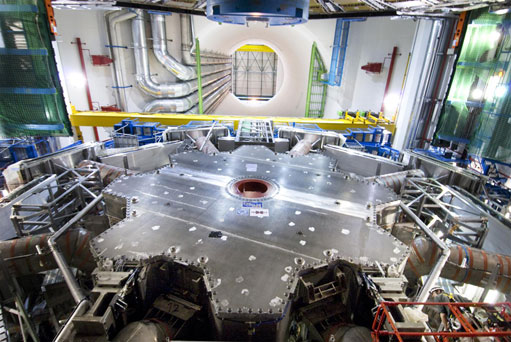
ATLAS e-News
23 February 2011
New plans for ATLAS
13 October 2008

To open the cavern, or keep recording cosmics with the magnets running?
After the incident that brought the LHC to a sudden stop, plans for getting the ATLAS detector ready for beam have been re-evaluated. On October 2nd, a special TMB/EB meeting decided on the new planning for ATLAS during the shut down.
The main outcome of the meeting was the decision to start opening the detector on October 21st. Not an easy decision as the opening date has implications on the work schedule of the different sub-detectors and it may not be the best timing for all of them.
“Some sub-detectors want to keep the detector closed and get data with the magnetic field on for as long as possible, because they get lots of useful data that they can later on analyse and use,” says Thorsten Wengler, ATLAS Run Coordinator. On the other hand, as Thorsten points out, in order to learn if there is something that needs repair work, the detector has to be open.
“In the end, it’s a trade-off between keeping the magnetic field and data taking on longer, and starting to open the detector earlier,” says Thorsten. All members in both committees supported the final decision.
Here are the views and plans from three ATLAS system project leaders.
Leonardo Rossi, Inner Detector project leader
![]() The ID will actually remain closed up to early December, as it has had little time for detailed commissioning so far. We will therefore proceed with calibrations and stand-alone data taking up to early December, while the outer parts of ATLAS are being opened. The activity during the winter shut down will imply opening the ID End-Plate to make some repairs and measurements, which were cut short during installation.
The ID will actually remain closed up to early December, as it has had little time for detailed commissioning so far. We will therefore proceed with calibrations and stand-alone data taking up to early December, while the outer parts of ATLAS are being opened. The activity during the winter shut down will imply opening the ID End-Plate to make some repairs and measurements, which were cut short during installation.
We also plan modifications of the evaporative cooling distribution racks to allow for fine granularity monitoring of critical parameters. This is expected to minimize the down-time of the ID in case of problems. Finally opto-transmitter plug-ins must also be changed both for the Pixel and the SCT, these parts are located on racks in the USA cavern and this operation can therefore be done at the very end of the shut-down. 
Isabelle Wingerter, Liquid Argon Calorimeter project leader
![]() There are some pieces of equipment in the Liquid Argon Calorimeter which need repair and we will use the shut down period to do so. We know about our LVPS (Low Voltage Power Supplies) since April. More recently two new types of failures occurred: one HEC-LVPS is broken and transmitters in six Front End Boards (FEBs) have stopped emitting light in recent weeks: ‘It never rains but it pours’ as English people say. The HEC-LVPS is on the C side and three of the six FEBs are on the A side!
There are some pieces of equipment in the Liquid Argon Calorimeter which need repair and we will use the shut down period to do so. We know about our LVPS (Low Voltage Power Supplies) since April. More recently two new types of failures occurred: one HEC-LVPS is broken and transmitters in six Front End Boards (FEBs) have stopped emitting light in recent weeks: ‘It never rains but it pours’ as English people say. The HEC-LVPS is on the C side and three of the six FEBs are on the A side!
It was difficult to decide which side to open first. We discussed among us and with Marzio, and decided the A side will be opened first. We shall extract the three FEBs and analyse them as soon as possible; luckily, the HEC-LVPS is at the bottom of the End Cap C cryostat and we shall be able to have access to it as soon as the C side is slightly open.
Ludovico Pontecorvo, Muon project leader
![]() The optical fibres that are used in the read-out of the MDT Big Wheels (BW) are not radiation-hard and need to be replaced. We are going to use this shut down to replace all those fibres since we consider it a mandatory operation. This will be done first on the BW-C and later on, at the end of the winter 2009 on BW-A.
The optical fibres that are used in the read-out of the MDT Big Wheels (BW) are not radiation-hard and need to be replaced. We are going to use this shut down to replace all those fibres since we consider it a mandatory operation. This will be done first on the BW-C and later on, at the end of the winter 2009 on BW-A.
Last spring, some TGC chambers in the EIL4 and in the Small Wheel (SW) were damaged after an accident on the gas system. Chambers on EIL4 sector 7 have been already replaced, and we will replace one chamber in sectors 5, 9 and 11 each.
During the winter shut down, we also have to recover one RPC chamber in the Muon Barrel that has high gas leaks and this implies moving out one BOL chamber. During this shut down we are also going to upgrade all the CSM (read-out boards) of the barrel MDT.

Cristina JimenezATLAS e-News |